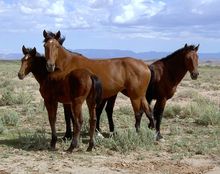New information highlights the need to keep wild horses on the range after over 75 wild horses captured in Bureau of Land Managementâs (BLMâs) fall 2014 âWyoming Checkerboard roundupâ died in the days and months after capture, adding significantly to the official death toll from this capture operation in the Adobe Town, Salt Wells Creek and Divide Basin Herd Management Areas (HMAs) in southwestern Wyoming.

Wild horses on open range
Over 75 wild horses captured in Bureau of Land Managementâs fall 2014 âWyoming Checkerboard roundupâ died in the days and months after capture.
© 2015 by Kersti Nebelsiek
Previously, the BLM had reported the deaths of 14 horses as a direct result of the helicopter roundup, but records obtained under the Freedom of Information Act by the American Wild Horse Preservation Campaign (AWHPC) show a significantly higher death toll.
"BLM often touts a death rate of one percent for helicopter roundups, but these records shed light on the very significant number of deaths that occur in the holding facilities in the days and months after the horses are rounded up,â said Suzanne Roy, Campaign Director of the AWHPC. "The leading cause of death is traumatic injury â primarily broken necks from terrified horses crashing into the bars of their holding pens in desperate escape attempts.â
These records are further evidence of the trauma, terror and suffering that the BLM inflicts on Americaâs wild horses and burros with its roundup program,â Roy continued. âThis cruel treatment is far below the standard Americans expect for treatment of our national icons.
We have a choice to continue to spend tens of millions of taxpayer dollars to brutally roundup and remove wild horses from their homes on the range, or we can humanely manage them in the wild using the effective and cheaper PZP birth control vaccine, where necessary, to control population numbers.â
This controversial roundup resulted in the capture and removal of 1,263 wild horses between September 15 and October 9, 2014.
- 22 horses died due to traumatic injury in the holding pens, including broken necks, spinal and pelvis injuries, fatal leg damage sustained in the helicopter stampede; another 7 horses died due to lameness.
- 12 horses die from complications due to gelding, including hemorrhaging to death.
- 11 horses died from strangles, a highly contagious respiratory infected which can become rampant in holding facilities.
The actual death toll is even higher, AWHPC noted, because the numbers do not include deaths of foals who perish before they are old enough to be branded and entered into the BLMâs tracking system.
Previously, AWHPC analyzed post-capture deaths from the 2010 Calico Mountains wild horse roundup in Nevada and found that the majority of deaths were related to the trauma and stress of the roundup and capture, the trauma associated with social loss sustained in the destruction of horse family bands, and the ongoing stress of captivity in an unnatural environment
âThe bad news for wild horses only begins with the gather,â wrote Dr. Bruce Nock, Associate Professor at the Washington University School of Medicine and expert on the physiological effects of stress on animals, in a 2010 report prepared for the AWHPC.
âTo these wild horses, the sources of stress must seem endless. Everything is foreign⦠truly disturbing for a species that depends on familiarity for safety and comfort. . . It is extremely detrimental to their long-term health and soundness.â
Last month, AWHPC and its coalition partners won a partial victory in their lawsuit against the BLM for the checkerboard roundup, when a U.S. District Court judge in Wyoming ruled that the BLM had violated the National Environmental Policy Act in proceeding with the roundup in the absence of proper analysis and public input.
(AWHPC) is a coalition of more than 60 horse advocacy, public interest, and conservation organizations dedicated to preserving the American wild horse in viable, free-roaming herds for generations to come, as part of our national heritage. AWHPC was founded in 2004.
